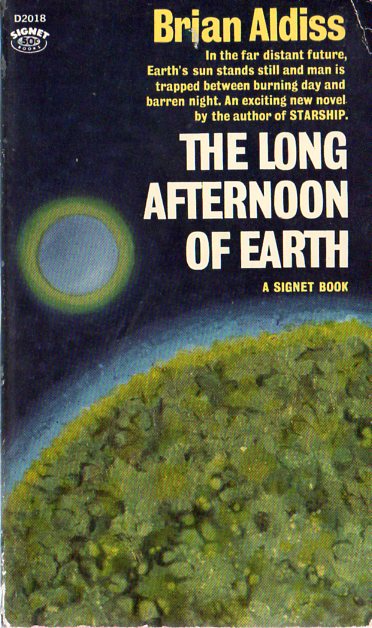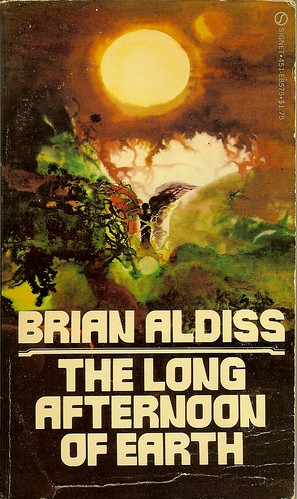So I have no difficulty in Lewis liking it (much SF he thought stupid and shallow, he'd not have said that without reading the stuff
Lewis was very well-read in science fiction and was one of the first academics (or the first?) publicly to promote it. Here's an article relevant to the topic.
C. S. Lewis and American Pulp Science Fiction
By Dale Nelson
C. S. Lewis, Oxford don and then Cambridge scholar specializing in medieval and Renaissance literature – an impressionable reader of American science fiction pulps?
The inventor of Narnia – indebted to the co-founder of Arkham House?
It seems so. Lewis made no secret of these debts. In
The Great Divorce, he refers to two stories that he thinks came from the cheaply-printed pages of the pulps. He was wrong about one of the stories. The story he refers to in the preface has to have been “The Man Who Lived Backwards,” by the forgotten British author Charles Hall and appeared in a British magazine. But apparently Lewis was so deeply read in the American pulps that he just assumed that he’d read the story, which features raindrop like bullets, in one of them. The other story is alluded to in a footnote: “This method of travel also I learned from the ‘scientifictionists’.”
“Colossus,” which first appeared in the January 1934 issue of
Astounding, appears to be the story that suggested to Lewis the idea, central to
The Great Divorce, of travel from one universe to a much vaster one -- travel during which the vehicle and passenger(s) expand concomitantly so as to “fit“ the new cosmos. The universe -- ours -- that is left behind in Donald Wandrei’s story is but an atom relative to the size of the universe that is entered. Similarly, in
The Great Divorce the immense, sprawling city of Hell is an invisible point relative to the vastness of Heaven’s borderland. The spaceship
White Bird, piloted by the intrepid Duane Sharon, expands in Wandrei’s story: “According to the law propounded decades ago by Einstein, the
White Bird, all its contents, and he, himself, would undergo a change, lengthening in the direction of flight” as they travel thousands of times the speed of light (54, 56/130). The busful of passengers from Hell expands so that, when it emerges from a tiny crack in the celestial soil, the holiday-makers are “to scale.”
Wandrei’s story may also have suggested to Lewis something of the splendor of outer space that Ransom discovers in
Out of the Silent Planet. Sharon beholds “[w]hite suns and blue, pale-orange and apple-green stars, colossal tapestry of night blazing with eternal jewels” and an “emerald sun, flaming in the radiant beauty of birth” (Wandrei 58,59/133, 134). Ransom contemplates “planets of unbelievable majesty, and constellations undreamed of: there were celestial sapphires, rubies, emeralds and pin-pricks of burning gold” (Lewis 31); space is not dead but rather is “the womb of worlds” (32).
I wonder if Wandrei ever read
The Great Divorce or
Out of the Silent Planet. Lewis may have been aware of the small press that Wandrei and August Derleth founded, since a catalog of books from Lewis’s library, prepared a few years after his death, included at least one AH book, Robert Bloch’s
The Opener of the Way. But don’t get too excited about the prospect. Likely enough, the book had belonged to Lewis’s wife, Joy, an American.
Now that you’ve had the chance to wrap your head around the idea of Lewis as pulp-mag reader, let’s consider a little historical background. C. S. Lewis’s “On Science Fiction” was read, or was the basis of a talk, at a 1955 session of the Cambridge University English Club (Hooper xix). In this paper, Lewis said that, “some fifteen or twenty years ago,” he “became aware of a bulge in the production” of stories of the type pioneered by H. G. Wells. Lewis said: “In America whole magazines began to be exclusively devoted to them” (“On Science Fiction” 55). This statement nails down the fact that Lewis read American pulp “scientifiction.” Such magazines were readily available to British readers. Richard Kyle recalls “bins of ‘Yank Magazines –
Interesting Reading’ in the English Woolworth stores of the middle ‘30s” (Lupoff 92).
Historian of science fiction Mike Ashley regards the “mid-thirties” as the time in which these magazines exhibited a phase of “cosmic sf,” emphasizing stories that dealt with “not just the exploration of space but the nature of time, space and the universe” (231). Along with “Colossus,” a couple of other such stories may have left traces in Lewis’s own science fiction.
Jack Williamson’s “Born of the Sun” (
Astounding, March 1934) may have had something do with Weston’s “rind” remarks at the end of Chapter 13 of
Perelandra (1943). In the Williamson story, some at least of the solar system’s moons, as well as its planets, are actually spawn or “‘seed of the Sun’” (Asimov 532): huge egg-like objects from which eventually hatch immense monsters (which possess the ability to fly in a vacuum!). When the planet Earth begins to hatch, there ensue apocalyptic consequences for human beings living on the outer surface of the shell. In Lewis’s novel, Weston describes the universe as a globe with a crust of “‘life’” (the crust, however, being time; it’s about seventy years thick for human beings). As one ages, Weston says, one sinks through the crust until he emerges into the dark, deathly “‘reality’” that God Himself does not know (168). In each story, there is the idea of humanity living on a thin surface beneath which is something truly appalling.
OK, maybe that’s a stretch. How about this one? Edmond Hamilton’s “The Accursed Galaxy” (
Astounding, July 1935) may have contributed two essential components to Lewis’s Ransom trilogy.
Hamilton’s story proposes that organic life, viewed very Un-Lewisly as a loathsome contagion, originated two billion years ago when one member of a race of immortal “volitient beings of force” was experimenting with matter. He accidentally released “the diseased matter” from his laboratory, and it rapidly spread from world to world. This “experimenter” (Asimov 717) was punished by the other force creatures by being confined in a “shell of frozen force” (719) that eventually descends to the earth. Human beings involuntarily set him free at the climax of the story. In addition to imprisoning the offender, the other force-creatures also caused the primal super-galaxy to break up into millions of galaxies, all the others rushing away from the infected core -- our own Milky Way galaxy. The vast (and increasing) distances of space effect a cosmic quarantine. Central to
Out of the Silent Planet (1938), of course, is the idea of the confinement to our earth of its “bent Oyarsa” (the devil), lest he do further damage, having already stricken the moon and Mars ages ago (121). In the first of the Ransom books, and in
Perelandra, human beings are the means by which the devil is enabled to threaten Mars and Venus.
Lewis’s eldila are described, in the Ransom trilogy, as appearing as light. For example, in the first chapter of
Perelandra, the narrator sees “a rod or pillar of light” of an unnamable color (18). The force-being who appears in “Accursed Galaxy” is a “forty-foot pillar of blazing, blue light, crowned by a disk of light” (Asimov 719). The edila “do not eat [or] suffer natural death” (
Perelandra 9), and Williamson’s force-beings are “immortal” and “[need] no nourishment” (Asimov 717).
It’s reasonable to surmise that Lewis was influenced by impressions of Hamilton’s story as he wrote his own “planet books,” but also that he had forgotten “The Accursed Galaxy,” or judged that his “revisions” of elements from Hamilton’s story were so thorough as to make allusion to it not obligatory.
So, was Prof. C. S. Lewis not only a reader of American pulp mag science fiction, but a writer influenced by it? I think so!
Ashley, Mike.
The Time Machines: The Story of the Science-Fiction Pulp Magazines
From the Beginning to 1950. Liverpool: Liverpool University Press, 2000.
Asimov, Isaac (ed.).
Before the Golden Age: A Science Fiction Anthology of the 1930s.
Garden City, N. Y.: Doubleday, 1974.
Hooper, Walter. “Preface.”
On Stories and Other Essays on Literature by C. S. Lewis.
San Diego: Harcourt Brace, 1982.
Lewis, C. S.
The Great Divorce. Glasgow: Fontana, 1972.
----------.“On Science Fiction.”
On Stories and Other Essays on Literature. San
Diego: Harcourt Brace, 1982.
- - - - - - - - - -.
Out of the Silent Planet. New York: Macmillan, 1973.
- - - - - - - - - -.
Perelandra. New York: Macmillan, 1969.
Lupoff, Richard A. and Patricia E. Lupoff.
The Best of Xero. San Francisco: Tachyon,
2004. This book is a selection of contributions to a classic fanzine of 1960-1962.
Wandrei, Donald. “Colossus.”
Astounding Stories Jan. 1934: 40-72. This story is reprinted, with some changes by the author, in:
Colossus: The Collected Science Fiction of Donald Wandrei. Ed. Philip J. Rahman and Dennis E. Weiler. Minneapolis: Fedogan and Bremer, 1989, pages 110-153. “Colossus” does not appear to have been reprinted until 1950 (several years after the composition and publication of
The Great Divorce), when it appeared in an anthology,
Beyond Time and Space, edited by August Derleth. “Colossus” may also be found in Asimov’s
Before the Golden Age anthology.
(c) Dale Nelson 2015; printed originally in Pierre Comtois's magazine Fungi, (c) ca. 2010.









